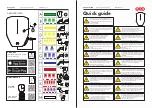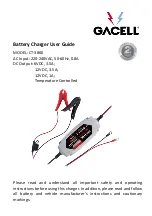
DRIVING OVER LOGS
Review the path ahead before attempting to cross any
obstacle. Review the obstacle from outside the vehicle
for an understanding of the terrain condition in front of
and behind the obstacle. Approach obstacles slowly
and inch the vehicle over, approaching at a 15-degree
angle. If a large obstacle near the log such as a rock
cannot be avoided, choose a path that places the rock
directly under the tire rather than the undercarriage of
the vehicle. This helps prevent damage to the vehicle.
DRIVING OVER ROCKS AND GRAVEL
Gravel is a constantly changing, low-grip surface.
Driving at slow speeds on gravel reduces the risk of
losing traction when you stop, accelerate or take
a corner.
When approaching large rocks, position the vehicle
so that the tires pass over the largest obstacle. Never
attempt to straddle a rock that is large enough to strike
your axles or undercarriage, or drive over a rock which
is large enough to contact the door sills. If you lose
traction on your uphill wheels, stop immediately and
choose a more suitable route.
Leave a generous gap between your vehicle and other
vehicles, to minimize the risk of damage from flying
gravel. Avoid dust clouds as they reduce visibility.
DRIVING THROUGH WATER
As the water depth increases, reduce your vehicle
speed to avoid potential vehicle damage. The key to a
safe crossing is the water depth, current and bottom
of the water’s condition. On soft bottoms, the vehicle
sinks in, effectively increasing the water level on the
vehicle. Make sure to consider this when determining
the depth of water.
Determine the depth and speed of the current before
attempting a water crossing. Be aware that obstacles
and debris may be beneath the water’s surface. Drive
slowly when crossing water. Proceed with a constant
slow speed lightly pressing on the accelerator. Drive
through the water very slowly when entering, then
build up momentum. Keep your vehicle moving at a
steady pace. Refer to the
Driving Hints
chapter of your
Owner’s Manual
for additional limitations
and precautions.
DRIVING YOUR VEHICLE AT HIGH SPEEDS
If you plan on using your vehicle for severe, high-speed
off-road use, we recommend doing a low-speed
reconnaissance run in unfamiliar areas to become
aware of any obstacles that you could encounter.
Your vehicle can incur damage if driven beyond its
capabilities. Skid plates and rock rails are designed to
help limit damage to vital components and exterior
finishes, but cannot prevent all damage if driven in
extreme off-road conditions. Refer to the
Driving
Hints
chapter of your
Owner’s Manual
for additional
information and precautions.
OFF ROAD
Содержание BRONCO 2023
Страница 6: ...5 4 2 3 1 6...
Страница 8: ...12 13 7 11 8 9 10 18 17 16 15 14...















































